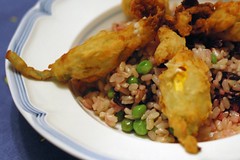
A few years back, I took a one-day CIA class named State of the Art Professional Wine Service. Not all the lessons stuck: To this day I have a 10 percent chance of pulling out a cork with an Ah-So opener and a 90 percent chance of shoving it into the wine. But I will never forget the moment when the teacher asked us to name three reasons for decanting wine. We called out the first two—separating old wine from sediment and letting young wine aerate—but the third eluded us. Finally, she said, "Because it's so beautiful."
That simple statement kicked off my small decanting fetish. I watch waiters and wine stewards do it at other tables, and I relish the chance to do it at home. I swirl young wines in our ship's captain decanter, peering through the garnet sheet that spreads along the bottom.
I had high hopes for Sandra Jordan's The Art of Decanting. How could I resist a whole book focused on my secret delight?
But don't bother with this fluffy book. Decanting occupies just a slice of the pages. Corks, corkscrews, glasses, bottles, wine appreciation, and more occupy the rest. Forget any depth with so many topics crowded into this slender volume. I confess that I hadn't heard the term monteith before, but that was all I gleaned from the book. (It's a large, shallow bowl for chilling wine glasses, often with scalloped edges to hold the stems.)
The book made more sense after I read Jordan's back flap bio. She designs "a high-end line of wine country-inspired lifestyle products for the home." Jordan's love for the wine world's accessories approaches fetishism. Photos of simple and complex examples of each object fill the book, demonstrating that wine, like any other hobby, has an infinite amount of gear to buy.
The pictures and presentation suggest a triumph of form over function, and the writing continues the theme. Hyperbole and overwrought prose swirl across the pages. Should they ever make an audiobook version, the publisher should recruit James Lipton to deliver the bombast the text requires. "The glass decanter is the bottle's best ally, for it receives the bottle's precious cargo and opens it to the edifying air." "The decanter stands upon the table; full now, its bounty expands, in scent and flavor, with the air." A deft hand could manage this florid text, but Jordan wings them at the reader in a constant flow, a blinding stream of gilded lilies.
I can forgive the light coverage and the ornate wording as a style choice, but I have no patience for her shoddy information. For a fetishist such as Jordan, screw caps and other new closures must seem crass, but she doesn't mention them in the cork chapter—even to dismiss them as lower life forms—despite their surge in the marketplace. She accepts without question the Riedel marketing speak about glass shapes tailored to each wine, even though controlled tests and two minutes of critical thought argue against the sales patter. (See my similar rant when the Chronicle ran a Riedel puff piece).
But worst of all: "Finally, the server will wish to smell the cork. Beware a moldy odor, Hugh Johnson cautions, which may indicate that the wine is 'corked' (or tainted by TCA, a combination of mold and other unsavory elements) and thus undrinkable. If all is well with the cork, however, then one can feel confident in moving on to the next delightful steps of wine service." Despite Jordan's attempt to bring in an expert, she misses the key word may. You can have a skanky cork atop a great wine and a musty drink when the cork is fine. The only way to know if a wine is corked is to smell it in the glass. "Sniffing the cork" is a common misconception, but Jordan's family is shoulder-deep in the wine industry; they should know better. (By the way, TCA is not "a combination of mold and other unsavory elements," but a specific molecule—2,4,6-trichloranisole—that often comes from mold. If the sentence was a victim of missing-serial-comma syndrome, then I retract this aside and replace it with a complaint about the lack of parallel structure in the list.)
The wine fetishist in your life may appreciate this glorified Wine Enthusiast catalog of accessories, but everyone else can skip it.
Labels: Book Reviews, Wine Wine Wine











